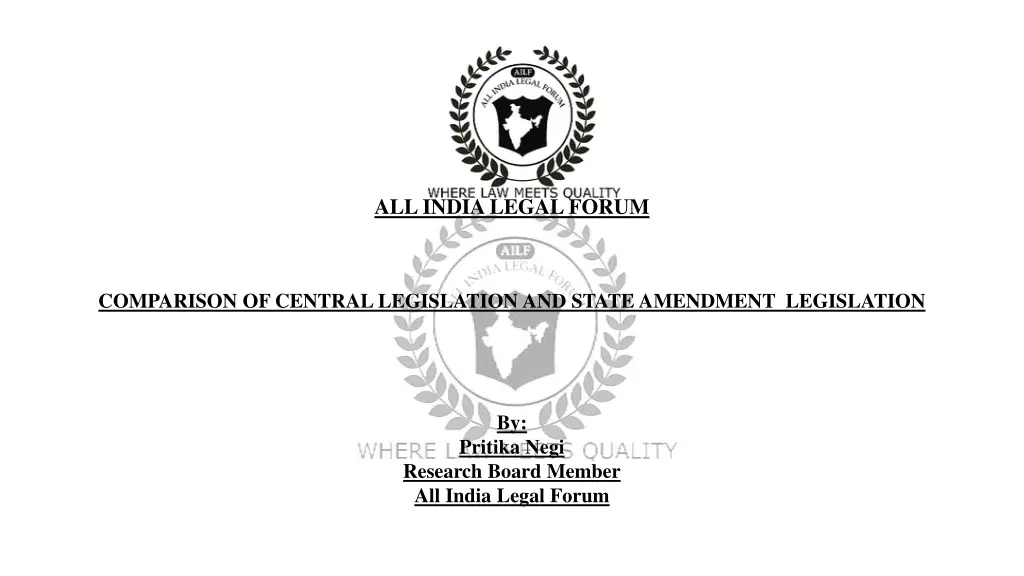
Comparison of Central Legislation and State Amendment Legislation in Street Vending Laws
Explore the differences between the Street Vendors (Protection of Livelihood and Regulation of Street Vending) Act, 2014 and the U.P. Street Vendors (Protection of Livelihood and Regulation of Street Vending) Rules, 2017, focusing on definitions, local authorities, and the role of Town Vending Committees.
Download Presentation

Please find below an Image/Link to download the presentation.
The content on the website is provided AS IS for your information and personal use only. It may not be sold, licensed, or shared on other websites without obtaining consent from the author. If you encounter any issues during the download, it is possible that the publisher has removed the file from their server.
You are allowed to download the files provided on this website for personal or commercial use, subject to the condition that they are used lawfully. All files are the property of their respective owners.
The content on the website is provided AS IS for your information and personal use only. It may not be sold, licensed, or shared on other websites without obtaining consent from the author.
E N D
Presentation Transcript
ALL INDIA LEGAL FORUM ALL INDIA LEGAL FORUM COMPARISON OF CENTRAL LEGISLATION AND STATE AMENDMENT LEGISLATION By: Pritika Negi Research Board Member All India Legal Forum
COMPARISON ON THE Street Vendors (Protection of Livelihood and Regulation of Street Vending) Act, 2014 AND THE U.P. Street Vendors (Protection of Livelihood and Regulation of Street Vending) Rules, 2017
Street Vendors (Protection of Livelihood and Regulation of Street Vending) Act, 2014 Street Vendors (Protection of Livelihood and Regulation of Street Vending) Act, 2014 was the Act No. 7 of 2014. It came into effect from the date it was published in the Official Gazette, i.e., the fourth day of the third month of the year 2014.. The act was enforced in order to protect the rights of the urban street vendor of whole of India (except Jammu and Kashmir). However, the provisions of the act do not extend to any premise which is under the control of the Railway Act, 1989. The Street Vendors (Protection of Livelihood and Regulation of Street Vending) Act, 2014 was enacted by the parliament in the year 2014. The Act consists of 39 sections and ten chapters. It also includes two schedules.
Important Definitions Local Authority [Section 2(c)]: The term loacal authority includes Municipal Corporation, Municipal Council, Nagar Panchayat, Cantonment Board or any other committee/ body constituted to regulate land use of the city/town, street vending activities and provide civic services. Stationary vendors [Section 2(k)]: Stationary vendors are those vendors who work in a specific area on routinely basis. Street vendors [Section 2(l)]: the term refers to the person who is engaged in any vending activity and is thus helping the public (either in public or private places) and is by virtue of street vending engaged in some sought of employment. Town Vending Committee [Section 2(m)]: The body termed as the Town Vending Committee is constituted by the appropriate government. It may either be 1 or more than one in a single zone or ward. Further, the organisation of the committee is mentioned in section 22 of the Act.
U.P. Street Vendors (Protection of Livelihood and Regulation of Street Vending) Rules, 2017 The U.P. Street Vendors (Protection of Livelihood and Regulation of Street Vending) Rules, 2017 was published in U.P. Gazette on 10Thday of the fifth month of the year 2017. In order to protect and preserve the rights of the urban street vendors, the power to make rules for the same is inferred upon the Governor of the State. This power to form state rules is vested upon the Governor of the State of U.P. by virtue of section 6 of the Street Vendors (Protection of Livelihood and Regulation of Street Vending) Act, 2014 (Act no 7 of 2014). The State legislation consists of 30 sections, some of which are formed in accordance with the Street Vendors (Protection of Livelihood and Regulation of Street Vending) Act, 2014 (Act no 7 of 2014), whereas others are extension to the above mentioned Central Legislation Act. The U.P. Street Vendors (Protection of Livelihood and Regulation of Street Vending) Rules came into force on the third year of commencement of the Street Vendors (Protection of Livelihood and Regulation of Street Vending) Act, 2014 .
Important Definitions Act [Section 2(a)]: The term Act here refers to the Street Vendors (Protection of Livelihood and Regulation of Street Vending) Act, 2014. Certificate of Vending [Section 2(b)]: Certificate of vending is that certificate that is issued by the Town vending committee to the street vendors in order to allow them to initiate vending in a particular area mentioned in the certificate. No Vending Zone [Section 2(g)]: The area/zone where vending is not permitted are known as no vending zones. Restricted Vending Zone [Section 2(i)]: Any area/zone where vending is permitted for a specific time period is known as restricted vending zone. Vending Charges [Section 2(l)]: The amount payable by the vendor who possess a certificate of vending is known as the vending charge .
Need for formation of U.P. State Vendor Rules, 2017 The Street Vendors (Protection of Livelihood and Regulation of Street Vending) Act, 2014, enacted by the Parliament for providing the urban street vendors their rights and mentioning their duties and responsibilities, was created and enforced for not any single community of any specific area, but for whole of the India. The act was also enforced to regulate the street vending activities and to manage other related activities. However, since India is such a diverse nation with several communities with their own languages, customs, ideologies, etc. it was seen that a central legislation might not be able to cover every situation. Thus, state legislations were created. The provisions of the state legislations formed were in accordance with the provision of the central legislation. One such example of state legislation is : The U.P. Street Vendors (Protection of Livelihood and Regulation of Street Vending) Rules, 2017. Some provisions of the state legislations, i.e., The U.P. Street Vendors (Protection of Livelihood and Regulation of Street Vending) Rules, 2017 (here) are same as mentioned in the central legislative act, i.e., The Street Vendors (Protection of Livelihood and Regulation of Street Vending) Act, 2014, however some of the provisions included in the state legislation are not mentioned in the central legislation and might also vary from the same.
Similarities between the two Acts The provisions mentioned in the U.P. Street Vendors (Protection of Livelihood and Regulation of Street Vending) Rules, 2017 are same as mentioned in The Street Vendors (Protection of Livelihood and Regulation of Street Vending) Act, 2014 and is also mentioned number of times in the same. These examples include section 2(a), 2(2), 14(4)(v), and many more. One of the important statement implicitly mentioned in the U.P. Street Vendors Rules, 2017 is that all the vending activities must be done according to what is mentioned in the vending certificate, and the acts or the urban vendors of the State of U.P. shall not be in contradiction with the provisions of the Street Vendors Act, 2014. For instance, lets take example of section 14(4)(v) of the U.P. Street Vendors Rules, 2017 which speaks about penalties incurred on violation of the terms of the Street Vendors Act, 2014. The offender is punishable under the Street Vendors Act, 2014 i.e., in accordance to the section 28 of the Act. Cancellation of the vending certificate is always done in accordance with the provisions mentioned in section 10 of the Street Vendors Act, 2014.
Continued Reason of eviction of the street vendors in both the Acts are same and mentioned in section 18(2) of the Street Vendors Act, 2014 and section 20(a), 20(b), and 20(c) of the U.P. Street Vendors Rules, 2017. It talks about the applicability and validity of the certificate of vending. The formation of the Town Vending Committee is to be done according to the provisions of section 22 of the Street Vendors Act, 2014. Be it for a municipality (under the U.P. Street Vendors Rules, 2017) or for whole of India. The Scheme prescribed for planning and proper construction is supposed to be done in accordance with section 38 of the Street Vendors Act, 2014. The above-mentioned statement is prescribed in section 2(k) of the U.P. Street Vendors Rules, 2017 and section 2(j) of the Street Vendors Act, 2014. Maintenance as mentioned in Section 14(4)(vi) in U.P. Street Vendors (Protection of Livelihood and Regulation of Street Vending) Rules, 2017 and Section 16 of the Street Vendors (Protection of Livelihood and Regulation of Street Vending) Act, 2014.
Continued Penalty of rupees 2000 is prescribed under section 30(2) of the U.P. Street Vendors Rules, 2017 and Section 28 of the Street Vendors Act, 2014 for all those who commit an offence. Survey must be conducted of all the street venders in accordance with the provisions mentioned under section 3 of the Street Vendors Act, 2014.
Differences S. No. Street Vendors (Protection of Livelihood and Regulation of Street Vending) Act, 2014 U.P. Street Vendors (Protection of Livelihood and Regulation of Street Vending) Rules, 2017 The Act came into force from 10thmay, 2017. 1. The Act came into force from 1st May, 2014. 2. The Act is enforceable in whole of India. The Act is enforceable in the merely in the state of Uttar Pradesh. 3. The local authority mentioned herein includes all states, towns and cities (exclusive of the state J&K). Section 1(2) of the Act mentions that the provisions of the act must be applicable to all the Municipal Corporations, Municipal Councils and Nagar Panchayats of the state. Section 18 of the Act speaks about responsibilities of a street vendor. Nothing of such relevance is mentioned herein. 4.
Continued 5. No mention is made to the quorum. Section 8 of the act mentions that atleast one third of the members must be present throughout in order to transact a business. 6. No separate section mentioning responsibilities of the street vendors was constructed. The Act not only speaks about rights but also about responsibility and liabilities. Section 18 of the Act speaks about the responsibilities of the street vendors. 11 subclauses were formed under section 18 for this purpose. 7. Section 17 mentions facilities to be provided in vending zones. Section 23 of the Act extensively mentions facilities provided to the street vendors by the Municipality.
Continued 8. An appeal can be made against the decision of the Town Vending committee to the local authority mentioned in section 2(c). This right of submitting an appeal is mentioned under section 11 of the Act. The time period of submitting an appeal is not prescribed. An appeal can be made against the decision of the Town Vending Committee to the Mayor or the Chairperson with respect to section 24 of the act. 9. The appeal is to be submitted within 30 days from the date of receiving the receipt of the order. The Town Vending Committee shall meet at-least four times in a year. 10. No routine of any such meetings of the Town Vending Committee is prescribed in the act. No separate section is construed herein for the same. 11. Section 3 of the Act mentions the prohibitions laid on the vendors.
Continued 12. Vague explanation is delivered as to when the Town Vending Committee shall meet. The meeting is called by the Chairperson of the Town Vending Committee when requisition is made by at-least one-third of the Committee members in writing. 13. The Town Vending Committee consists of a Chairperson, members appointed by the government, at-least 10 per cent of the members nominated by the non- governmental organizations and at-least 40 per cent street vendors selected by the street vendors itself. And among which the women population must be one-third. Other than the nominations mentioned in the Street Vendors Act, 2014 other nominations are mentioned in section 4(2)(e)(i) 4(2)(e)(xv).
Conclusion The Street Vendors (Protection of Livelihood and Regulation of Street Vending) Act, 2014 was enacted by the Lok Sabha on 6 September, 2013 and by the Rajya Sabha on 19 February, 2014. The Act received an assent on $ March, 2014 and was thus commenced from the first date of the fifth month of the year 2014. After inferring better understanding of the problem faced by different states, a need for a separate state legislation arose. Further, in order to ensure better implementation different act for different states were made. These state legislations no where went in contradiction to the Street Vendors Act, 2014, but was merely an extension of the provisions of the same. One of these act was the - U.P. Street Vendors (Protection of Livelihood and Regulation of Street Vending) Rules, 2017. These laws helped to curb problem of basic interpretation of the clauses and whom to approach in times of occurrence of any violation of the street vendors rights, etc.


